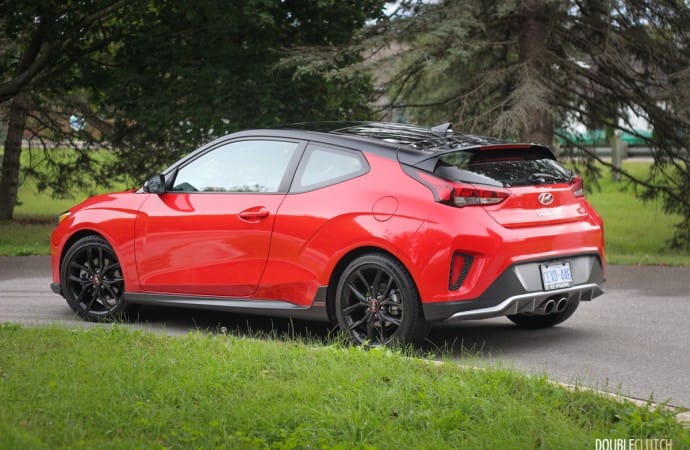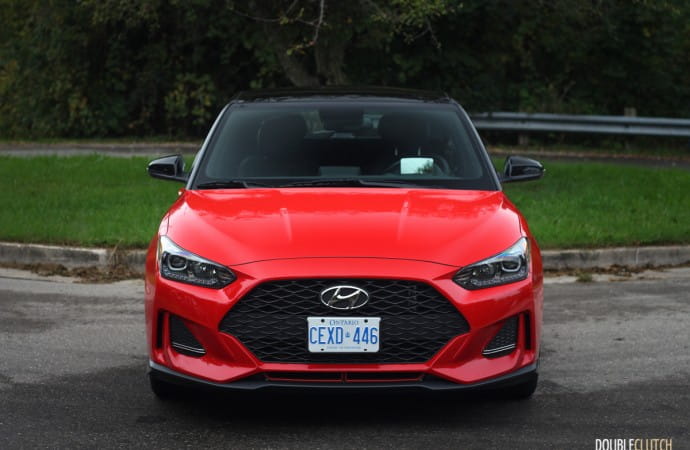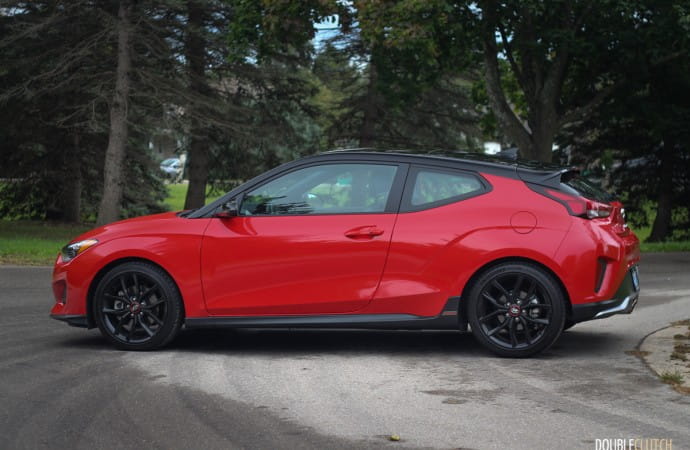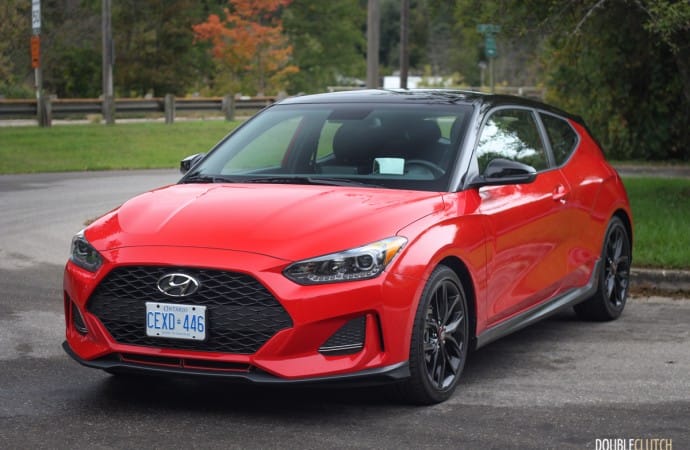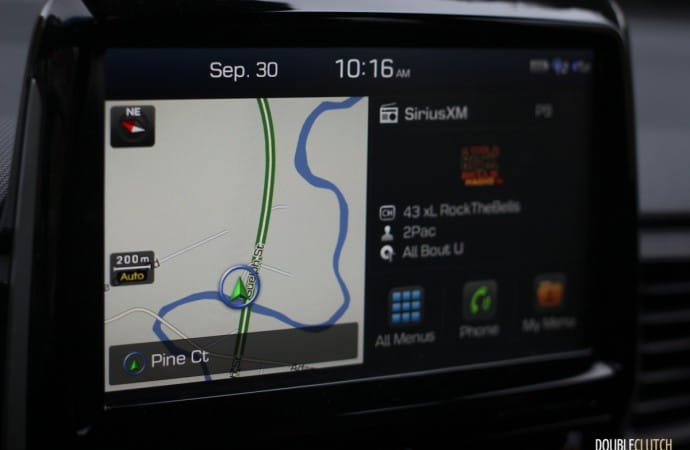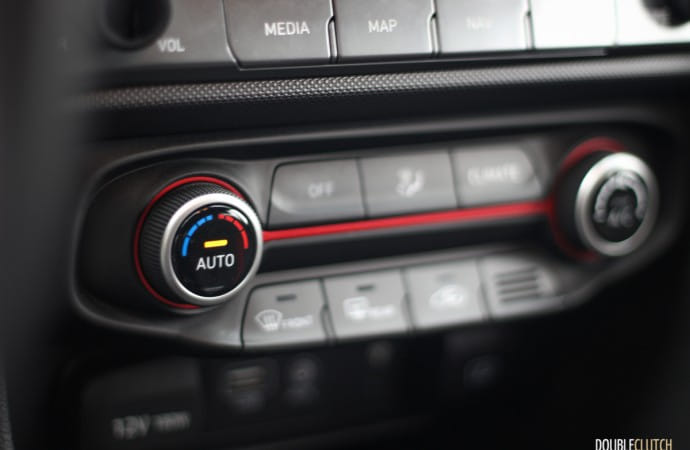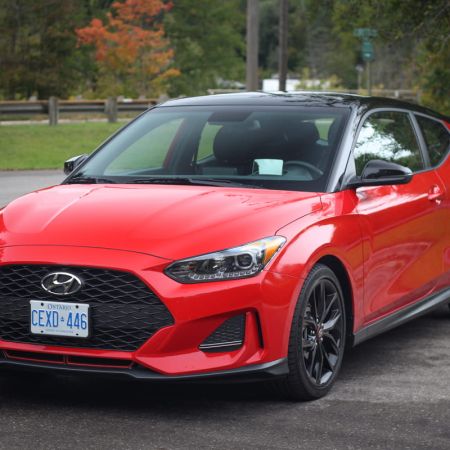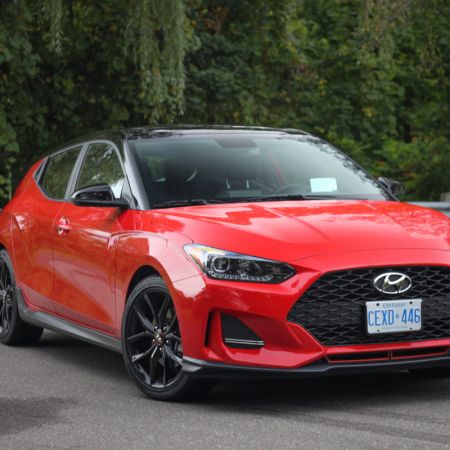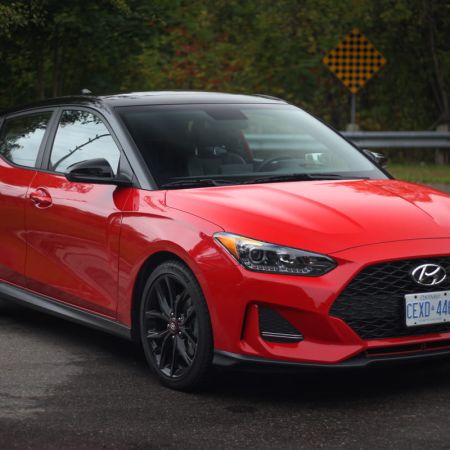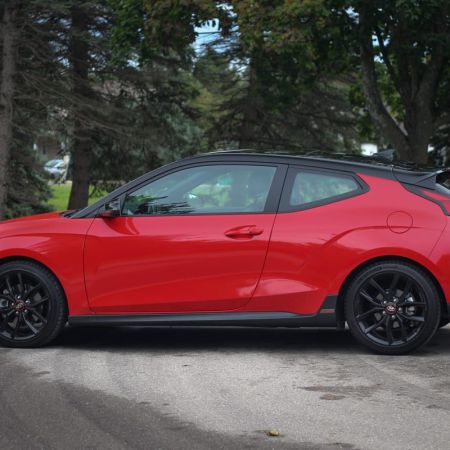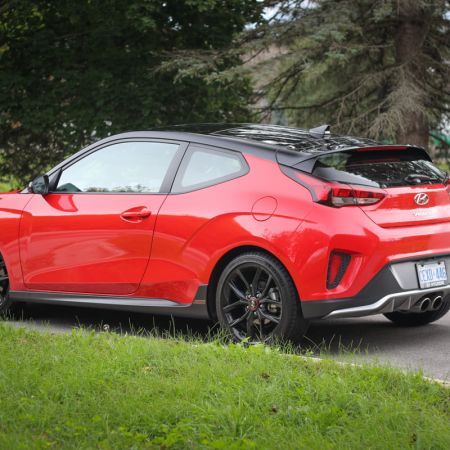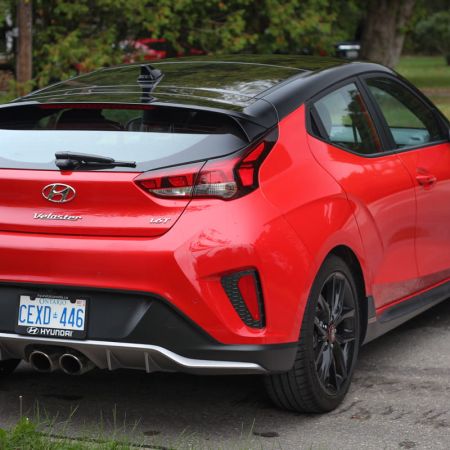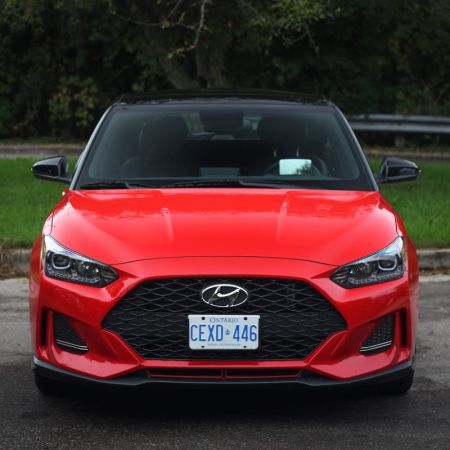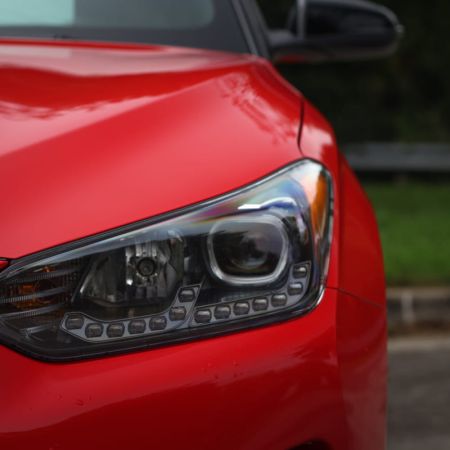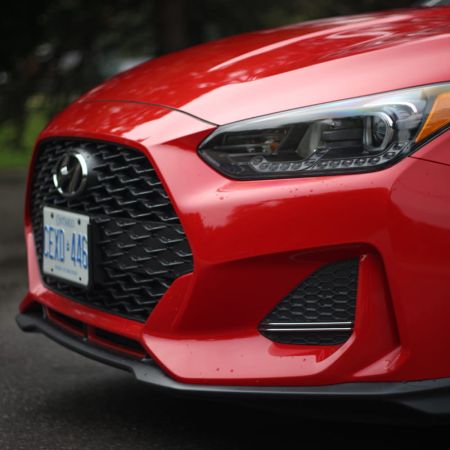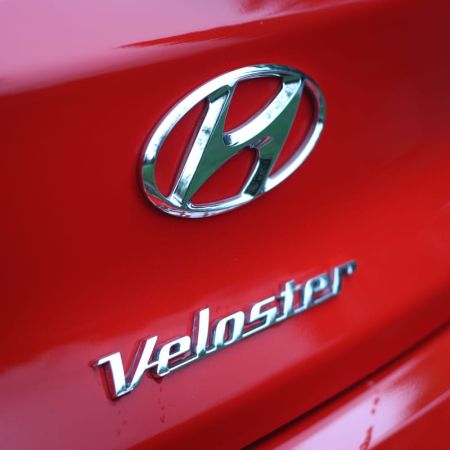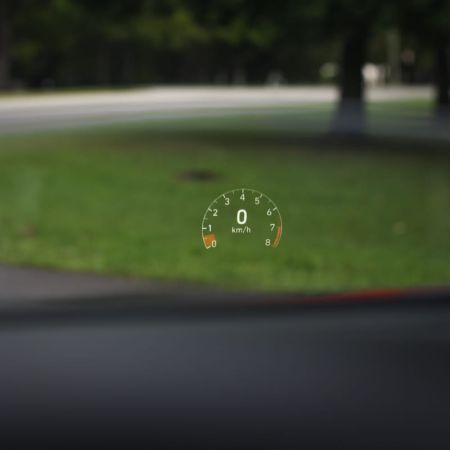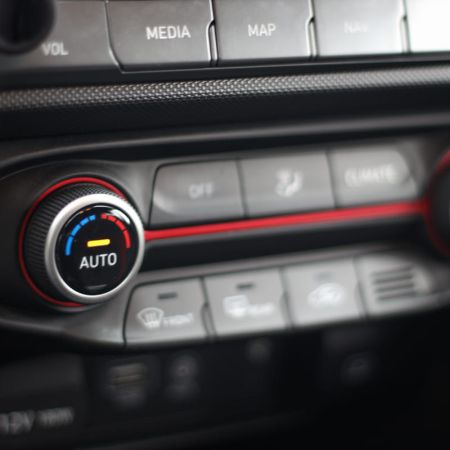With the recent focus on the crossover market, the first generation model had grown overdue for an update. The Honda Civic Si, and the Veloster’s stable mate, the Elantra Sport (reviewed here) have really been the two top contenders for most sport compact shoppers recently. However, the team at Hyundai are undoubtedly counting on the all-new Veloster’s unique personality and styling to take another bite out of the Civic’s sales.
The styling of the new Veloster will likely be a key to its success (or failure) and for that reason it seems like Hyundai has played it fairly safe. They’ve worked with a design that is evolutionary rather than revolutionary from the first generation car. The new car is notably more conservative than the original; but nonetheless looks handsome wearing the latest Hyundai corporate fascia, which has been well integrated into the design.
Of course, the Veloster is still a quirky beast, and perhaps the weirdest thing about it is the one rear door, on the right side only. It takes some time getting used to the car’s asymmetrical design, but it does make for a nice conversation starter. The lines are fluid, yet closer inspection reveals some very deliberate and expertly executed creases that tie into the more aggressive fascia. They work well with the factory dark grey skirt package on the Turbo model to really drive home the modern sense of style.
Turbo models also get two huge center mount exhaust tips, a rear diffuser, and 18” gloss black wheels which can be wrapped in outstanding Michelin Pilot Sport 4 tires when you opt for the Performance Package. The Veloster Turbo’s styling, and the sporty wheel and tire combo mean it’s rolling out of the factory with quite a bit of street cred.
Fortunately, the turbocharged models do have the performance to back up its sporty looks. The 1.6L turbocharged four-cylinder puts out 201 horsepower and 195 lb-ft. of torque from 1,500 to 4,500RPM. This is a significant upgrade over the standard 2.0L Atkinson-cycle four-cylinder that’s good for 147 horsepower, and even that number is increased over the outgoing car. Both engines are available with the six-speed manual, as equipped in our tester, or the turbo can be had with a six-speed dual clutch auto (while the 2.0L would get a traditional six-speed automatic).
The 1.6L turbo does suffer from a bit of turbo lag, but keeping the RPMs up above 4000RPM delivers plenty of power, which in this tight and tossable platform makes the Veloster turbo plenty of fun to drive. The soundtrack provided by the unique center-mounted exhaust also adds to the overall experience. The Veloster loud enough for those nearby to know it’s there, but not loud enough to be a distraction.
Similarly to the Elantra Sport, which shares many components, the Veloster’s platform is very apt to spirited driving and thus, well balanced. It’s easy to toss the little hatchback through high-speed sweeping corners, or whip through tighter corners with confidence despite the lack of feel from the electronically assisted steering. Using “Sport” mode does increase the weight of the otherwise very light steering, but it does little for the overall feel.
The Veloster Turbo also lacks a limited slip differential, but does have a torque vectoring control (TVC) system that does an adequate job of keeping the little car going exactly where you point it when pushed. Day-to-day driving in the Veloster is also fairly comfortable with decent ride quality over a variety of surfaces, but we did find the steering a bit twitchy on the highway and the road noise from the meaty Michelins can be a bit intrusive on longer highway runs.
Efficiency is a strong point for the Veloster Turbo. After a week’s worth of rush hour commuting, and some spirited driving in the mix, our average sat right at 7.5L/100km. This puts the Veloster in line with its closest competitors; however it is one of the few turbocharged sport compacts on the market today that is perfectly happy on regular fuel.
The interior in the Veloster is a bit of a mixed bag with some high points and some low points to consider. The dashboard is very similar to the layout in the Elantra, which is well thought out, clean and logical. Hyundai’s infotainment system runs well with easy-to-navigate menus and real volume and tuner knobs for audio controls. It also comes equipped with Apple CarPlay and Android Auto, important tech considering the Veloster’s younger target demographic.
The basic gauge cluster is supplemented by a heads-up display included in the Technology Package, which uses a pop-up plastic screen from the dashboard. It’s a larger screen which means visibility is better than the one you’d find in a Mazda3 (reviewed here), but it still looks a bit cheap. The biggest letdown inside the Veloster is the quality of the materials. The door panels in particular have a lot of hard plastics that look and feel out of place in an otherwise well designed space. The same can be said for the flimsy interior door handles and seat adjustment levers.
Space inside the Veloster is well manage and extremely versatile, which is another one of the unique benefits of the odd three-door plus hatch design. Rear cargo space is one of, if not, the best in class, and even rivals that of many compact and subcompact crossovers. Rear passenger headroom does suffer thanks to the swooping roofline, as does access on the left side where there is no rear door, but younger buyers and children will make do.
Up front there are two nice big cupholders and a large storage bin at the front of the center console that includes a wireless charging pad, as well as larger door pockets, meaning the Veloster passes the daily carry items test easily. The heated leather sport seats equipped on our tester come finished in a respectable quality leather, with an interesting red accent stripe down the middle and good side bolstering for spirited corners. They were plenty comfortable for long commutes, too.
Hyundai vehilces typically do come better equipped than their closest competitors. This has been part of the corporate strategy for years now, and the Veloster is no exception. Even the most basic Veloster at $20,990 gets heated front seats, a heated steering wheel and the 7” touchscreen, along with blind spot monitoring, rear cross traffic alert and nice 18” wheels. The Turbo starts at $25,899 and also adds a large sunroof and LED exterior lighting, including some of the best LED projector headlights out there.
Expect to add between $1000 and $1,500 to the price tag if you want an automatic transmission as all models come standard with the manual. For an extra $600 on top of the basic Turbo you can get the Performance Package, which adds unique wheels and the wider 225/40R18 Michelin Pilot Sport summer performance tires. The Tech package is the biggest add-on, and with a $3,000 price tag you’ll get the nice leather sport seats, heads-up display, wireless charging pad and a larger 8” touch screen with navigation. Our tester came with both the Tech and Performance packages, plus a $250 charge for the Ignite Red paint bringing our as-tested price to $29,276.
The 2019 Hyundai Veloster Turbo really is a lot of car, both from a feature and performance standpoint for under $30,000. It also stacks up very well against its closest competitor, the Civic Si (reviewed here), thanks to the its more versatile cargo area, closely comparable performance stats, and slightly favorable pricing. The Civic is a bit more engaging to drive thanks to its livelier steering and limited-slip differential. As someone who values the extra practicality and personality the Veloster offers, I’d be hard pressed to choose between the two.
See Also:
2018 Subaru Impreza Sport 5-door
Road Trip: 2018 Mazda3 Sport GT

